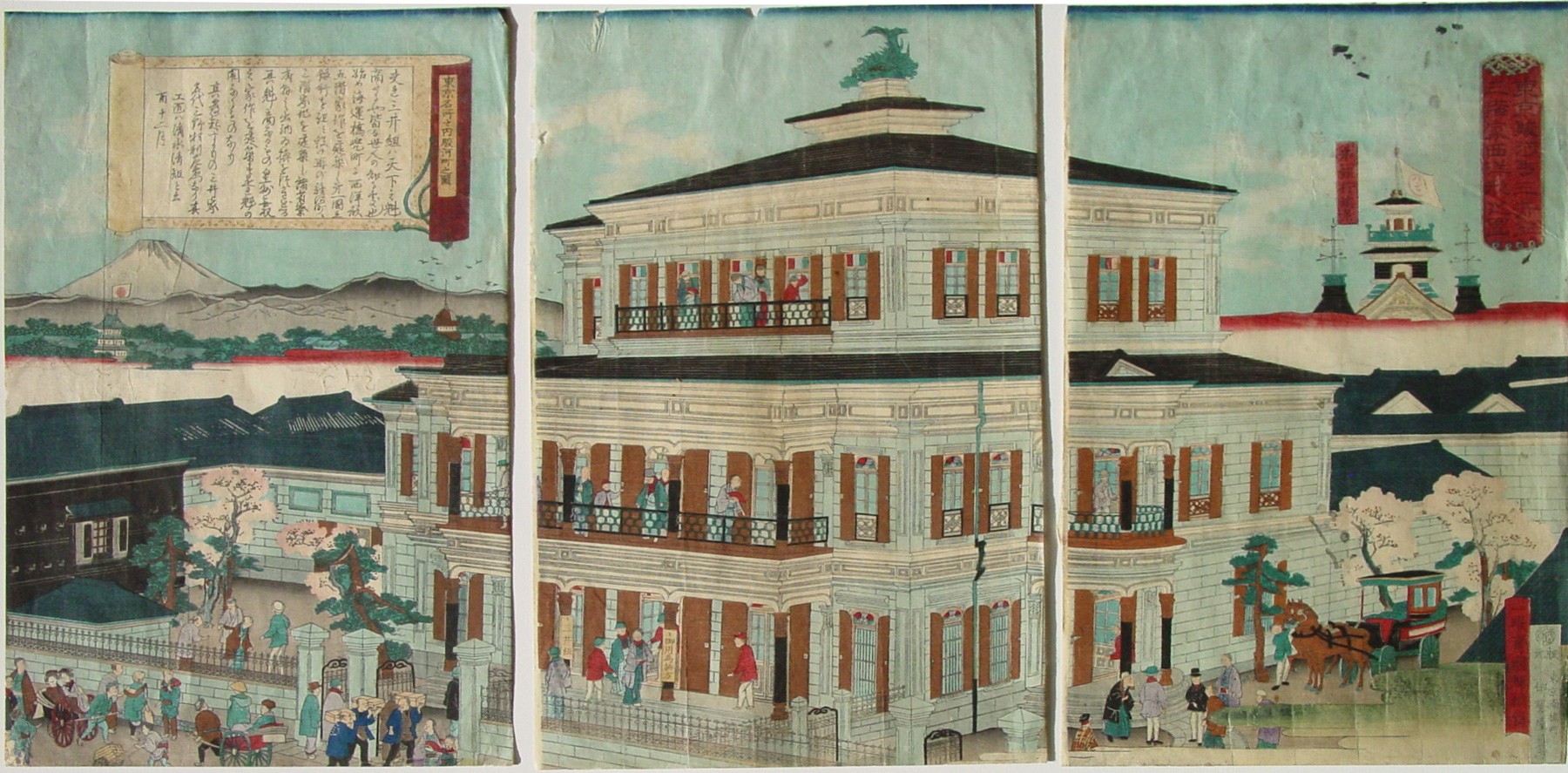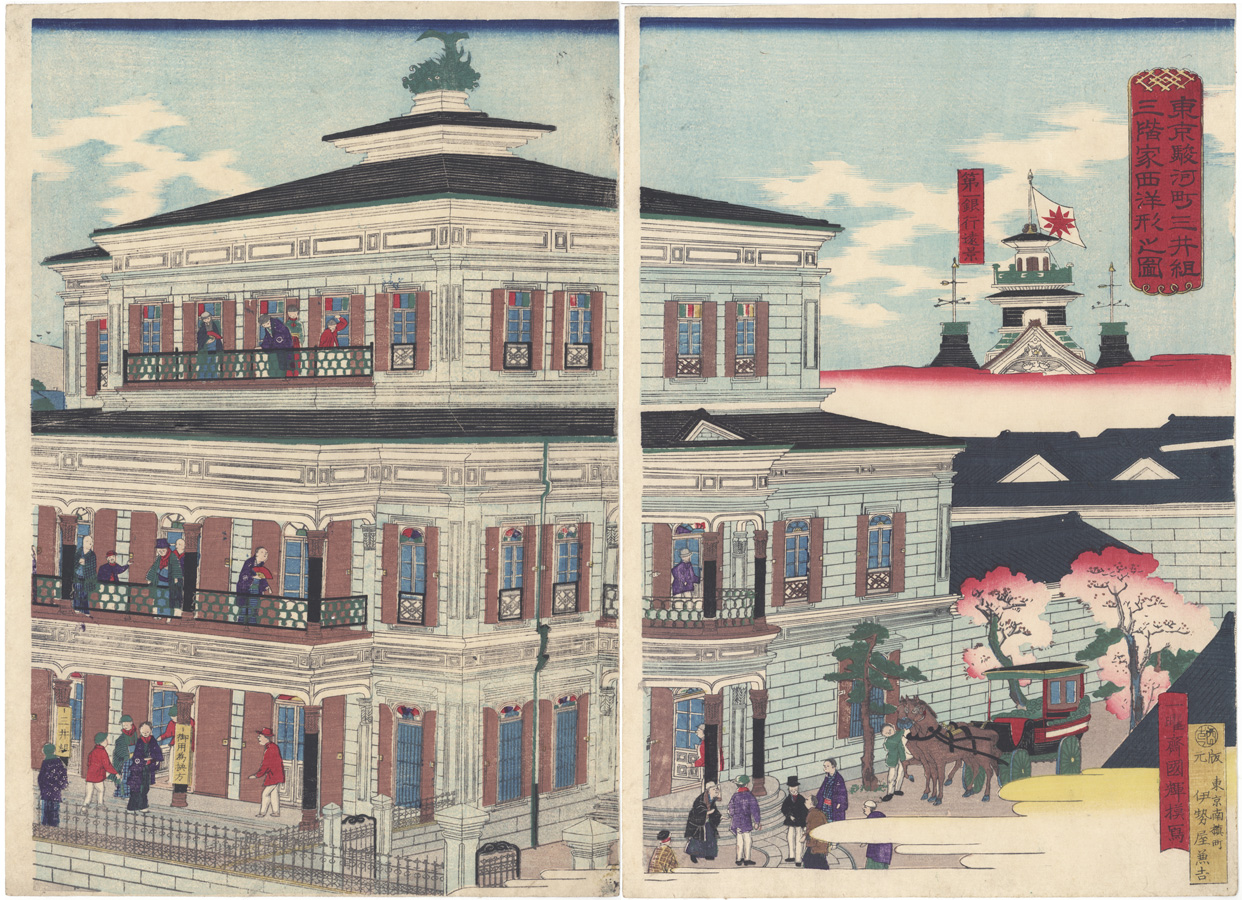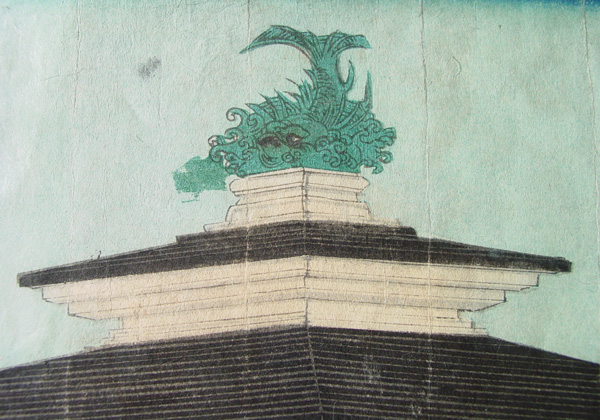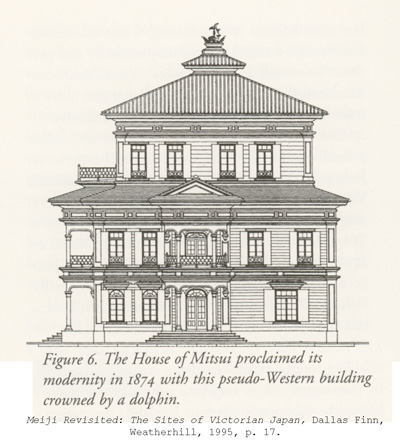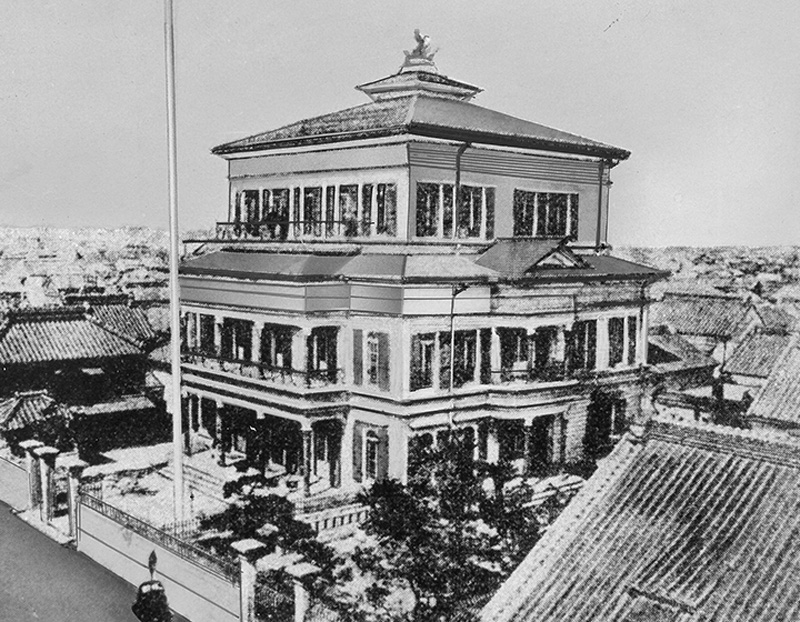About This Print
The Mitsui Exchange Bank, with its bronze dolphin on top, was a popular building depicted in a number of woodblock prints. This print made in December of 1873, prior to the cited 1874 completion date of the building, shows the building with Mt. Fuji to its left and the First National Bank [第一銀行], with its distinctive Western-style towers, completed in 1872, in the background to its right. The artist Utagawa Hiroshige III (1842–1894) created a similar view of the First National Bank building and Kuniteru II's design was popular enough for the publisher to have issued a variant color printing, shown below.
Variant color printing, 1873 by Kuniteru II
Tributes to European Architecture
Source: “The Modernization of Tokyo during the Meiji Period: Typological Questions,” Jinnai, Hidenobu appearing in Rethinking XIXth Century City, Attilio Petruccioli (ed). Cambridge, Massachusetts: The Aga Khan Program for Islamic Architecture,1998 and as footnoted.“In the early years of the Meiji era, when the remnants of old Edo were still abundant, two buildings were built as a tribute to European architectural culture. One was the First National Bank (1872)1 by the Kaiun Bridge; the other was the Mitsui Bank (1874) which faced a street in the Surugachō area. Both were the work of Kisuke Shimizu2, a master carpenter with traditional skills. They had an unusual design which mixed Japanese and Western styles by placing traditional castle-like roofs atop colonial-style buildings. The tall skyline created by the two buildings was very popular and regarded as a new symbol replacing Mt. Fuji. In both location and height the two were detached from the surrounding urban context, and that made the particularly prominent symbols of Japanese enlightenment by Western civilization.”
The Mitsui Exchange Bank was topped with a huge dolphin cast in bronze. “According to folklore, the green dolphin would protect it from fire; but the bank needed a more potent talisman against the holocaust that... would soon threaten the financial structure of Japan.”3
In the 1890s these buildings "became a public embarrassment and were torn down."4
| 為替バンク三井組/1874(明治7)年竣工 Mitsui Exchange Bank, Completed 1874 source: website of Shimizu Corporation |
1 The Mitsui Bank built in the commercial district of Suruga-cho (present-day. Nihonbashi Hongoku-cho, Tokyo), was built to be Mitsui's head office (known as Exchange Bank Mitsui-Gumi.) Mitsui-gumi had been active in currency exchange and trade in kimono fabrics since the Edo period (1603-1887) in Suruga-cho.
2 Shimizu also built the Tsukiji Hotel (the first Western-style hotel in Japan). It and the First National Bank (Dai-Ichi National Bank), were two other commercial buildings much pictured in woodblock prints of the period. Today, Shimizu Corporation, is a major construction company operating internationally.
3 Mitsui Three Centuries of Japanese Business, John G. Roberts, Tokyo: Weatherhill, 1973
4 Meiji Revisited The Sites of Victorian Japan, Dallas Finn, Weather Hill, Inc. 1995, p. 17.
Print Details
| IHL Catalog | #342 |
| Title or Description | Illustration of Mitsui Group's Western-style Three Story House at Surugachō, Tokyo 東京駿河町三井組 三階家西洋形之圖 東京名所之内駿河町之圖 [東京駿河町三井組 三階屋西洋形之図 東京名所之内駿河町之図 ] |
| Series | |
| Artist | Utagawa Kuniteru II (1830-1874) |
| Signature |  |
| Seal | none |
| Publication Date | December 1873 明治6年12月 (西十二 censor's date seal, see Publisher below) |
| Publisher |  板元 伊勢屋兼吉 hanmoto Iseya Kanekichi [Marks: pub. ref. 145; seal not shown] |
| Impression | excellent |
| Colors | excellent |
| Condition | IHL Cat. #342: fair - wrinkling, vertical folds, soiling throughout, numerous small holes, margin fraying, trimmed to image IHL Cat. #1817: excellent |
| Genre | ukiyo-e; kaika-e |
| Miscellaneous | |
| Format | horizontal oban triptych |
| H x W Paper | IHL Cat. #342: 14 1/4 x 9 3/8 in. (36.2 x 23.8 cm) each sheet IHL Cat. #1817: 14 7/16 x 9 7/8 in. (36.7 x 25.1 cm) each sheet |
| H x W Image | IHL Cat. #342: 14 1/4 x 9 3/8 in. (36.2 x 23.8 cm) each sheet IHL Cat. #1817: 14 x 9 9/16 in. (35.6 x 24.3 cm) right sheet 14 3/16 x 9 7/16(36 x 24 cm) center sheet |
| Literature | |
| Collections This Print | Bank of Japan Currency Museum ⅡBfカイ1/68 |
4/20/2020


